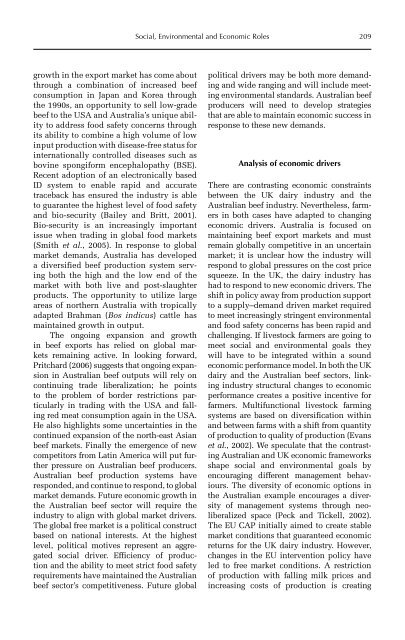Redesigning Animal Agriculture
Redesigning Animal Agriculture
Redesigning Animal Agriculture
You also want an ePaper? Increase the reach of your titles
YUMPU automatically turns print PDFs into web optimized ePapers that Google loves.
growth in the export market has come about<br />
through a combination of increased beef<br />
consumption in Japan and Korea through<br />
the 1990s, an opportunity to sell low-grade<br />
beef to the USA and Australia’s unique ability<br />
to address food safety concerns through<br />
its ability to combine a high volume of low<br />
input production with disease-free status for<br />
internationally controlled diseases such as<br />
bovine spongiform encephalopathy (BSE).<br />
Recent adoption of an electronically based<br />
ID system to enable rapid and accurate<br />
traceback has ensured the industry is able<br />
to guarantee the highest level of food safety<br />
and bio-security (Bailey and Britt, 2001).<br />
Bio-security is an increasingly important<br />
issue when trading in global food markets<br />
(Smith et al., 2005). In response to global<br />
market demands, Australia has developed<br />
a diversified beef production system serving<br />
both the high and the low end of the<br />
market with both live and post-slaughter<br />
products. The opportunity to utilize large<br />
areas of northern Australia with tropically<br />
adapted Brahman (Bos indicus) cattle has<br />
maintained growth in output.<br />
The ongoing expansion and growth<br />
in beef exports has relied on global markets<br />
remaining active. In looking forward,<br />
Pritchard (2006) suggests that ongoing expansion<br />
in Australian beef outputs will rely on<br />
continuing trade liberalization; he points<br />
to the problem of border restrictions particularly<br />
in trading with the USA and falling<br />
red meat consumption again in the USA.<br />
He also highlights some uncertainties in the<br />
continued expansion of the north-east Asian<br />
beef markets. Finally the emergence of new<br />
competitors from Latin America will put further<br />
pressure on Australian beef produ cers.<br />
Australian beef production systems have<br />
responded, and continue to respond, to global<br />
market demands. Future economic growth in<br />
the Australian beef sector will require the<br />
industry to align with global market drivers.<br />
The global free market is a political construct<br />
based on national interests. At the highest<br />
level, political motives represent an aggregated<br />
social driver. Efficiency of production<br />
and the ability to meet strict food safety<br />
requirements have maintained the Australian<br />
beef sector’s competitiveness. Future global<br />
Social, Environmental and Economic Roles 209<br />
political drivers may be both more demanding<br />
and wide ranging and will include meeting<br />
environmental standards. Australian beef<br />
producers will need to develop strategies<br />
that are able to maintain economic success in<br />
response to these new demands.<br />
Analysis of economic drivers<br />
There are contrasting economic constraints<br />
between the UK dairy industry and the<br />
Australian beef industry. Nevertheless, farmers<br />
in both cases have adapted to changing<br />
economic drivers. Australia is focused on<br />
maintaining beef export markets and must<br />
remain globally competitive in an uncertain<br />
market; it is unclear how the industry will<br />
respond to global pressures on the cost price<br />
squeeze. In the UK, the dairy industry has<br />
had to respond to new economic drivers. The<br />
shift in policy away from production support<br />
to a supply–demand driven market required<br />
to meet increasingly stringent envir onmental<br />
and food safety concerns has been rapid and<br />
challenging. If livestock farmers are going to<br />
meet social and environmental goals they<br />
will have to be integrated within a sound<br />
economic performance model. In both the UK<br />
dairy and the Australian beef sectors, linking<br />
industry structural changes to economic<br />
performance creates a positive incentive for<br />
farmers. Multifunctional livestock farming<br />
systems are based on diversification within<br />
and between farms with a shift from quantity<br />
of production to quality of production (Evans<br />
et al., 2002). We specu late that the contrasting<br />
Australian and UK economic frameworks<br />
shape social and environmental goals by<br />
encouraging different management behaviours.<br />
The diversity of economic options in<br />
the Australian example encourages a diversity<br />
of management systems through neoliberalized<br />
space (Peck and Tickell, 2002).<br />
The EU CAP initially aimed to create stable<br />
market conditions that guaranteed economic<br />
returns for the UK dairy industry. However,<br />
changes in the EU intervention policy have<br />
led to free market conditions. A restriction<br />
of production with falling milk prices and<br />
increasing costs of production is creating










